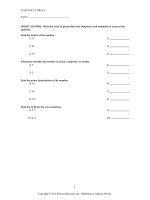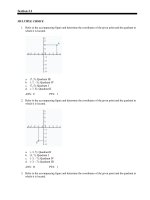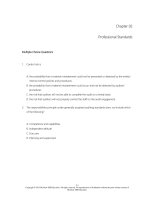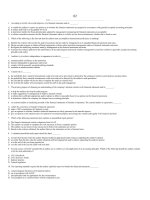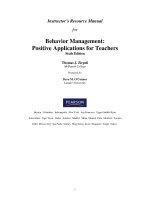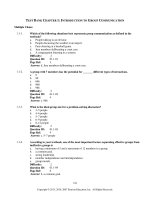Applied calculus brief 6th edition berresford test bank
Bạn đang xem bản rút gọn của tài liệu. Xem và tải ngay bản đầy đủ của tài liệu tại đây (480.22 KB, 33 trang )
Berresford/Rockett, Brief Applied Calculus, 6e
Chapter 2 Derivatives And Their Uses
1. Complete the table and use it to predict the limit, if it exists.
6x 7
f ( x) 1
2
5 x
lim f ( x) ?
x 0.5
x
f ( x)
0.51
0.501
0.5001
0.5
?
0.4999
0.499
0.49
A) –160.0
B) 80.0
C) –80.0
D)
0.5
E) does not exist
Ans: C
2. Use properties of limits and algebraic methods to find the limit, if it exists.
lim (8 x3 13x 2 3x 13)
x 3
A)
B)
C)
D)
E)
Ans:
3.
–121
121
141
–141
does not exist
B
x2 x
without using a graphing calculator or making tables.
x 5 2 x 5
A) 2
B) –5
C) 0
D) 4
E)
Ans: D
Find lim
©2013 Cengage Learning. All Rights Reserved.
Page 37
Berresford/Rockett, Brief Applied Calculus, 6e
4. Use properties of limits and algebraic methods to find the limit, if it exists.
–7 8 x
lim
x 1 4 144 x 2 5
A)
9
14
B)
1
14
C)
1
14
D)
9
14
E) does not exist
Ans: D
5. Use properties of limits and algebraic methods to find the limit, if it exists.
x 2 9 x 14
lim
x –5
x2 2x
A)
2
5
B)
2
5
C)
5
2
D)
5
2
E) does not exist
Ans: B
6. Use properties of limits and algebraic methods to find the limit, if it exists.
x 2 4 x 32
lim 2
x 13 x 9 x 8
A)
17
12
B)
17
12
C)
12
17
D)
12
17
E) does not exist
Ans: B
©2013 Cengage Learning. All Rights Reserved.
Page 38
Berresford/Rockett, Brief Applied Calculus, 6e
7. Use properties of limits and algebraic methods to find the limit, if it exists.
9 x h 9 x2
lim
h 0
h
A) 0
B)
2x
C)
9x
D) 18x
E) does not exist
Ans: D
2
8. A graph of y f ( x ) is shown and a c-value is given. For this problem, use the graph to
find lim f ( x) .
x c
c 2
A)
B)
C)
D)
E)
Ans:
0
2
–6
–4
does not exist
A
9. Use properties of limits and algebraic methods to find the limit, if it exists.
16 7 x for x 3
lim f ( x), where f ( x) 2
x 3
x 5 x for x 3
A) 5
B) 6
C) –6
D) –5
E) does not exist
Ans: E
10.
Find lim+ f ( x) for
x –6
A)
B)
C)
D)
E)
Ans:
f ( x)
x+6
x+6
.
6
–1
0
1
–6
D
©2013 Cengage Learning. All Rights Reserved.
Page 39
Berresford/Rockett, Brief Applied Calculus, 6e
11. Find lim f ( x) for the graph of f ( x ) given below.
+
x 3
A)
B)
C)
D)
E)
Ans:
12.
0
-3
inf
3
A
Find lim–
x –1
A)
B)
C)
D)
E)
Ans:
13.
1
0
–1
C
Find lim+
x 6
A)
B)
C)
D)
E)
Ans:
1
.
x +1
–1
x – 6
2
.
6
0
–6
E
©2013 Cengage Learning. All Rights Reserved.
Page 40
Berresford/Rockett, Brief Applied Calculus, 6e
14. For the given x-value, use the figure to determine whether the function is continuous or
discontinuous at that x-value.
x5
A) discontinuous
B) continuous
Ans: A
15. Determine whether the function is continuous or discontinuous at the given x-value.
x2 5
if x –4
f ( x) 2
x –4
9 x 123 if x –4
A) discontinuous
B) continuous
Ans: B
16. Determine whether the given function is continuous. If it is not, identify where it is
discontinuous.
y 3x 2 4 x 7
A) discontinuous at x 5
B) discontinuous at x 0
C) discontinuous at x 5
D) discontinuous at x 10
E) continuous everywhere
Ans: E
17. Determine whether the function is continuous or discontinuous at the given x-value.
x2 5
y
,
x –7
x4
A) continuous
B) discontinuous
Ans: A
©2013 Cengage Learning. All Rights Reserved.
Page 41
Berresford/Rockett, Brief Applied Calculus, 6e
18. Determine whether the given function is continuous. If it is not, identify where it is
discontinuous. You can verify your conclusions by graphing the function with a
graphing utility, if one is available.
8 x 2 3x 7
y
x 1 2
A) discontinuous at x 1 2
B) discontinuous at x 1
C) discontinuous at x 1
D) discontinuous at x 1 2
E) continuous everywhere
Ans: D
©2013 Cengage Learning. All Rights Reserved.
Page 42
Berresford/Rockett, Brief Applied Calculus, 6e
19. By imagining tangent lines at points P1 , P2 , and P3 , state whether the slopes are
positive, zero, or negative at these points.
A)
At P1 : positive slope
At P2 : negative slope
B)
At P3 : positive slope
At P1 : zero slope
At P2 : negative slope
C)
At P3 : positive slope
At P1 : zero slope
At P2 : positive slope
D)
At P3 : negative slope
At P1 : positive slope
At P2 : positive slope
E)
At P3 : positive slope
At P1 : positive slope
At P2 : negative slope
At P3 : negative slope
Ans: C
©2013 Cengage Learning. All Rights Reserved.
Page 43
Berresford/Rockett, Brief Applied Calculus, 6e
20. Which graph represents f ( x) if the graph of f ( x ) is displayed below?
A)
B)
C)
D)
©2013 Cengage Learning. All Rights Reserved.
Page 44
Berresford/Rockett, Brief Applied Calculus, 6e
E)
Ans: C
21. For the given function, find the average rate of change over the specified interval.
f ( x) 5 5 x 4 x 2 over –2, 4
A)
0
B)
–19
C) 19
D) 13
E)
–13
Ans: E
22. Find the average rate of change of f x 8 x 7 between x 3 and x 8 .
A) 8
B) 7
C) 3
D) 11
E) 5
Ans: A
23. Find the instantaneous rate of change of the function f x 6 x 2 5 x at x 2 .
A) 30
B) 26
C) 41
D) 42
E) 29
Ans: E
©2013 Cengage Learning. All Rights Reserved.
Page 45
Berresford/Rockett, Brief Applied Calculus, 6e
24. For the function in this problem, find the instantaneous rate of change of the function at
the given value.
f ( x) 9 x 2 5x 5; x 4
A) 0
B) 41
C) 31
D) 67
E) 77
Ans: D
25. For the function in this problem, find the slope of the tangent line at the given value.
f ( x) 5 x 2 9 x 9; x 1
A) 1
B) 14
C) –4
D) 0
E) 19
Ans: A
26. Find the slope of the tangent at x –1.
f ( x) 6 x 2 2 x
A) –14
B) –4
C) –10
D) 4
E) 0
Ans: C
27. For the function in this problem, find the derivative, by using the definition.
f ( x) 5 x 2 3 x 9
A)
5 x 2 3x 9
B)
5 x 2 3x
C) 10x
D)
5x 3
E)
10 x 3
Ans: E
28. Find the slope of the tangent to the graph of f (x) at any point.
f ( x) 9 x 2 6 x
A) 18x 6
B) 18x 6
C)
9x 6
D)
9x2 6 x
E)
3x
Ans: A
©2013 Cengage Learning. All Rights Reserved.
Page 46
Berresford/Rockett, Brief Applied Calculus, 6e
29. Find f ' x of f x –7 x 8 by using the definition of the derivative.
A)
f ' x 8
B)
f ' x –7
C)
f ' x 7x
D)
f ' x 7
E)
f ' x –7 x
Ans: B
30. Write the equation of the line tangent to the graph of f (x) at x –1.
f ( x) 5 x 2 8 x
A)
y –2 x 2
B)
y –2 x 2
C)
y –2 x
D)
y –2 x 5
E)
y –2 x 5
Ans: D
31. The population of a town is f x 3x 2 15 x 200 people after x weeks (for
0 x 20 ). Find f ' x to find the instantaneous rate of change of the population after
8 weeks.
A) 48
B) 64
C) 33
D) 31
E) 49
Ans: C
32. An automobile dealership finds that the number of cars that it sells on day x of an
advertising campaign is S x x 2 18 x (for 0 x 7 ). Find S ' x to find the
instantaneous rate of change on day x 2 .
A) 14
B) 18
C) 16
D) 22
E) 21
Ans: A
©2013 Cengage Learning. All Rights Reserved.
Page 47
Berresford/Rockett, Brief Applied Calculus, 6e
33. Differentiate the given function.
9 x6
y
6
A)
6x5
B)
9x 6
C)
9x 7
D)
54x 5
E)
9x 5
Ans: E
34. Find the derivative of g w 20 4 w .
A)
5
g w
4
w3
B)
20
g w
4
w3
C)
4
g w
4
w3
D)
g w 5 4 w3
E)
g w 20 4 w3
Ans: A
35. Find the derivative of the function.
y 5x 1 9 x 2 13
A)
–5 x 2 18 x 3
B)
–5 x 2 18 x 3
C)
–5 18x 1
D)
–5 x 2 9 x 3
E)
–5 x 1 9 x 2
Ans: B
36. For the function given, find f '( x).
f ( x) x 4 13x 8
A)
x 3 13
B)
4 x3 8
C)
4 x3 13
D)
4 x 4 13 x
E)
x 4 13 x 8
Ans: C
©2013 Cengage Learning. All Rights Reserved.
Page 48
Berresford/Rockett, Brief Applied Calculus, 6e
37. Find the derivative of the function.
f ( x) 9 x 8/ 3 9 x 10/ 3
A)
–24 x 11/ 3 30 x 13/ 3
B)
–24 x 5/ 3 30 x 7 / 3
C)
–24 x 11/ 3 30 x 13/ 3
D)
–24 x 5/ 3 30 x 7 / 3
E)
–72 x 11/ 3 90 x 13/ 3
Ans: C
38.
Find the derivative of f x
A)
B)
C)
D)
E)
f x
f x
f x
2
4
x3
2
4
x5
4
4
f x
f x
8
.
x
4
x3
4
4
x5
2
4
x5
Ans: B
39. Find the derivative of the function.
y 7 x4 2x2 6x 7
A)
28 x 4 4 x 2 6 x 7
B)
28 x 3 4 x 6
C)
7 x3 2 x 6
D)
28 x 3 4 x
E)
7 x4 2 x2 6 x 7
Ans: B
40. Find the derivative of the function.
h( x) 11x 21 19 x11 7 x8 14 x 6
A)
220 x 20 190 x10 49 x 7 14
B)
231x 21 209 x11 56 x8 14 x
C) 11x 20 19 x10 7 x 7 14
D)
231x 20 209 x10 56 x 7 14
E)
220 x 21 190 x11 49 x8 14 x
Ans: D
©2013 Cengage Learning. All Rights Reserved.
Page 49
Berresford/Rockett, Brief Applied Calculus, 6e
41.
Find the derivative of h x 3 3 x 2
A)
B)
C)
D)
E)
h x
h x
h x
h x
h x
1
x
2
2
x
2
3
x
1
2
x
2
2
x
3
3
6
.
x
1
3
x4
2
2
x3
2
3
x4
1
2
x3
2
2
x3
Ans: C
42. At the indicated point, find the instantaneous rate of change of the function.
R( x) 17 x 2 x 2 , x 3
A) 29
B) 52
C) 19
D) 21
E) 23
Ans: A
43.
If f x 60 4 x 3
A)
f 81 14
B)
f 81 15
C)
f 81 21
D)
f 81 16
E)
f 81 26
972
, find f 81 .
4
x
Ans: D
44. Find the derivative at the given x-value with the appropriate rule.
y 8 24 x at x 9
A) –8
B) –64
C) 8
D) –4
E) 0
Ans: D
©2013 Cengage Learning. All Rights Reserved.
Page 50
Berresford/Rockett, Brief Applied Calculus, 6e
45.
If f x x 5 , find
A)
B)
C)
D)
df
dx
x –2
df
dx
x –2
df
dx
df
dx
46.
–192
320
x –2
–128
x –2
80
x –2
If f x
A)
B)
C)
D)
250
df
30 x , find
dx
x
df
dx
x 25
df
dx
x 25
df
dx
df
dx
.
x 25
2
–2
10
x 25
–10
x 25
E)
df
dx
Ans: A
.
x –2
–32
E)
df
dx
Ans: E
df
dx
4
x 25
47. Suppose the Marginal Cost Businesses can buy multiple licenses for PowerZip data
compression software at a total cost of approximately C x 24 x 2 3 dollars for x
licenses. Find the derivative of this cost function at x 64 .
A)
C 64 8
B)
C 64 4
C)
C 64 2
D)
C 64 12
E)
C 64 6
Ans: B
©2013 Cengage Learning. All Rights Reserved.
Page 51
Berresford/Rockett, Brief Applied Calculus, 6e
48. Suppose the number of people newly inflected on day t of a flu epidemic is
f t 13t 2 t 3 (for 0 t 13) . Find the instantaneous rate of change of this number on
day 10.
A)
f 10 300
B)
f 10 –27
C)
f 10 –40
D)
f 10 230
E)
f 10 60
Ans: C
49. Find the derivative of f x 6 3 x 8 x 1 by using the Product Rule. Simplify your
answer.
A)
1
f x
32 3 x
3 2
x
B)
6
f x
32 3 x
3 2
x
C)
6
f x
64 3 x
3 2
x
D)
2
f x
64 3 x
3 2
x
E)
2
f x
32 3 x
3 2
x
Ans: D
50.
ds
if s t 6 8 t 3 8 .
dt
A)
6t 8 6t 5 24t 2
B)
9t 8 48t 5 3t 2
C)
6t 8 48t 5 24t 2
D)
9t 8 6t 5 3t 2
E)
9t 8 48t 5 24t 2
Ans: E
Find
©2013 Cengage Learning. All Rights Reserved.
Page 52
Berresford/Rockett, Brief Applied Calculus, 6e
51. Find the derivative, but do not simplify your answer.
y 7 x 7 3x3 9 x 3x5 8 x8 9 x9 6
A)
B)
C)
D)
E)
7 x 3x 9 x 15x 64 x 81x 49 x 9 x 9 3x 8x 9 x 6
15x 64x 81x 49x 9x 9
49 x 9 x 915x 64 x 81x
49 x 9 x 93x 8x 9 x 6 7 x 3x 9 x 15x 64 x 81x
7 x 3x 9 x 15x 64 x 81x 49 x 9 x 9 3x 8x 9 x 6
7
3
4
4
7
7
6
2
6
2
7
8
8
6
4
5
3
4
5
8
9
8
9
7
2
2
7
8
6
7
8
3
6
4
2
5
7
8
8
9
Ans: A
52. Find the derivative of f z z 28 z14 1 z15 z by using the Product Rule.
Simplify your answer.
A)
f z 43z 42 z
B)
f z 42 z 43 29 z 30 z 2
C)
f z 42 z 43 z 2
D)
f z 43 z 42 30 z 29 1
E)
f z 43 z 42 1
Ans: E
53.
Find the derivative of
1
.
x6
A)
1
6x 5
B)
6
x7
C)
1
6x
D)
6
x5
E)
1
6x 7
Ans: B
©2013 Cengage Learning. All Rights Reserved.
Page 53
Berresford/Rockett, Brief Applied Calculus, 6e
54. Find the indicated derivative and simplify.
7 x3
C ( x) for C ( x) 4
2x 7
2
4
A)
14 x 2 x 21
2
2x4 7
B)
x 2 2 x 4 21
2x 7
x 2 x 21
2x 7
7 x 2 x 21
2x 7
7 x 2 x 21
2x 7
2
4
C)
2
4
2
4
D)
2
4
2
4
E)
2
4
2
4
Ans: D
55.
Find the derivative of f x
A)
B)
C)
D)
E)
f x
12 x 2 40 x 5
4x
f x
f x
x5
by using Quotient Rule. Simplify your answer.
4 x2 5
5
2
3
4 x 2 40 x 5
4x
2
5
3
4 x 2 40 x 5
4x
2
5
2
f x
4 x 2 40 x 5
f x
12 x 2 40 x 5
4x
2
4x
2
5
2
5
2
Ans: D
©2013 Cengage Learning. All Rights Reserved.
Page 54
Berresford/Rockett, Brief Applied Calculus, 6e
56. Find the indicated derivative and simplify.
1 6x2
dy
for y 4
x 4x2 2
dx
A)
2 x 3x 4 x 2 4
x 4x 2
2 x 3x x 4
x 4x 2
4 x 3x x 4
x 4x 2
4 x 3x x 4
x 4x 2
4 x 3x x 4
x 4x 2
4
B)
3
4
C)
4
2
2
2
3
4
E)
2
2
4
D)
2
2
4
4
2
2
2
2
2
Ans: C
57.
x2 2
.
x2
3x 2 4 x 2
Find the derivative of f x x 6 3
A)
B)
C)
D)
E)
x2 2
f x 6x
x 6 3
x2
5
x 2
2
x2 2
x 6 3
x2
2
x2 4x 2
5 x 2
6
f x 6x
x 3
2
x2
x 2
f x 7 x6
x2 2
x 6 3
x2
2
x2 4x 2
6 x 2
6
f x 7x
x 3
2
x2
x 2
f x 6 x5
Ans: C
©2013 Cengage Learning. All Rights Reserved.
Page 55
Berresford/Rockett, Brief Applied Calculus, 6e
58. Find the indicated derivative and simplify.
x 4 x 7
f ( x) for f ( x)
x2 6
A)
11x 2 62 x 18
x
B)
6
2
6
2
2
2
2
11x 2 34 x 18
x
E)
3 x 2 68 x 18
x
D)
6
3 x 2 34 x 18
x
C)
2
2
6
2
11x 2 68 x 18
x
2
6
2
Ans: C
59.
Find the derivative of
A)
B)
1
1
4x
–1
C)
x –1
D)
E)
x+1
.
x–1
x2 1
x
x
–1
x–1
2
Ans: E
©2013 Cengage Learning. All Rights Reserved.
Page 56
Berresford/Rockett, Brief Applied Calculus, 6e
60. If the cost C (in dollars) of removing p percent of the particulate pollution from the
exhaust gases at an industrial site is given by
2000 p
C ( p)
,
130 p
find the rate of change of C with respect to p.
A)
4000000
130 p
B)
260000
130 p
C)
2
2
16900
130 p
2
D)
2000
130 p
E)
130
130 p
Ans: B
61. The number of bottles of whiskey that a store will sell in a month at a price of p dollars
2250
per bottle is N ( p )
. Find the rate of change of this quantity when the price is
p2
$9.
A) –18.60
B) 204.55
C) –18.75
D) 18.50
E) –9.30
Ans: A
62. After x months, monthly sales of a compact disc are predicted to be S ( x) x 2 (125 x3 )
thousand. Find the rate of change of the sales after 2 months in thousands per month.
A) –48
B) 452
C) 420
D) 476
E) 468
Ans: C
©2013 Cengage Learning. All Rights Reserved.
Page 57
Berresford/Rockett, Brief Applied Calculus, 6e
63. Find f ( x) and f ( x).
f ( x) 6 5 x 5 x 3
A)
f ( x) 5 15 x 2 , f ( x) 30 x
B)
f ( x) 30 x, f ( x) 30
C)
f ( x) 15x 2 , f ( x) 30 x
D)
f ( x) 5 15x 2 , f ( x) 30
E)
f ( x) –10, f ( x) 0
Ans: A
64. Find the third derivative.
y 7 x3 5 x 2 7 x
A)
42
B)
42x
C)
21
D)
21x
E) 0
Ans: A
65. Find the indicated derivative.
Find y (4) if y x8 8x3 .
A)
336x 5
B)
336x 4
C)
336 x 4 48 x
D) 1680 x5 48 x
E)
1680x 4
Ans: E
66. Find f ''( x) for the function
A)
99 72
x
4
B)
99 72
x
8
C)
11 92
x
2
D)
99 72
x
16
E)
11 92
x
4
Ans: A
x11 .
©2013 Cengage Learning. All Rights Reserved.
Page 58
Berresford/Rockett, Brief Applied Calculus, 6e
67. Find f '''( x) for the function
A)
399 152
x
4
B)
6783 152
x
8
C)
399 172
x
4
D)
6783 152
x
16
E)
399 172
x
8
Ans: B
68. Find f (4) ( x) for the function
A)
9009 92
x
4
B)
9009 52
x
8
C)
143 72
x
8
D)
9009 52
x
16
E)
143 72
x
16
Ans: D
x 21 .
x13 .
69. Find the second derivative.
1
h( x ) x 6 6
x
A)
30
42x 4 8
x
B)
42
42x 4 8
x
C)
42
30x 4 8
x
D)
30
42x 4 4
x
E)
42
30x 4 4
x
Ans: C
©2013 Cengage Learning. All Rights Reserved.
Page 59
Berresford/Rockett, Brief Applied Calculus, 6e
70.
Find f ''(5) for the function
1
.
4x 3
A)
1
625
B)
1
500
C)
3
3125
D)
9
500
E)
1
4
Ans: C
71. Find the third derivative.
2
y 3
x
A)
–120
x5
B)
120
x6
C)
0
D)
40
x5
E)
–120
x6
Ans: E
72. Find the second derivative of the function ( x 2 3)( x 2 7) .
A)
4 x3 8 x 21
B)
4 x3 8 x
C) 12 x 2 20
D) 12 x 2 8
E)
4 x 3 20 x 21
Ans: D
73.
Evaluate the expression
A)
B)
C)
D)
E)
Ans:
d3 7
x
dx 3
.
x 1
7
42
–42
–210
210
E
©2013 Cengage Learning. All Rights Reserved.
Page 60
Berresford/Rockett, Brief Applied Calculus, 6e
74.
Find the second derivative of the function
A)
2x 7
.
2x 7
56
(2 x 7)3
B)
112
(2 x 7)3
C)
112
(2 x 7)3
D)
28
(2 x 7) 2
E)
28
(2 x 7) 2
Ans: C
75. If the formula describing the distance s (in feet) an object travels as a function of time t
(in seconds) is s 60 90t 17t 2 . What is the acceleration of the object when t 5?
A) 0 ft/sec2
B)
–34 ft/sec2
C)
–80 ft/sec2
D)
34 ft/sec2
E)
80 ft/sec2
Ans: B
76.
After t hours, a car is a distance s(t ) 60t
300
miles from its starting point. Find the
t4
velocity after 6 hours.
A) 51 miles/hour
B) 66 miles/hour
C) 54 miles/hour
D) 57 miles/hour
E) 63 miles/hour
Ans: D
77. If f ( g ( x)) x 2 3x 2
x
A)
B)
x 3
C)
x 2 3x 2
D)
x 2 3x 2
E)
x 3x 2
Ans: D
and f ( x) x , find g ( x) .
©2013 Cengage Learning. All Rights Reserved.
Page 61

